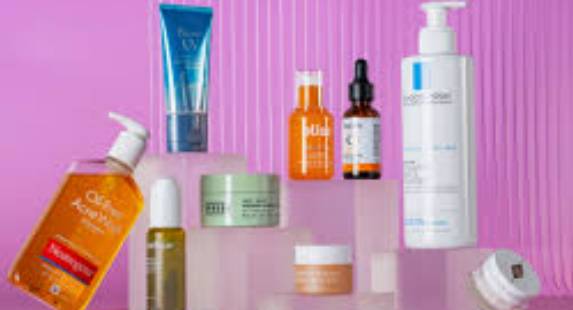Skin Care!
*Basic Skin Care Steps:*
1. Cleanse: Remove dirt and impurities with a gentle cleanser.
2. Tone: Balance skin pH and tighten pores with a toner.
3. Exfoliate: Remove dead skin cells 1-3 times a week.
4. Essence/Serum: Apply active ingredients for specific skin concerns.
5. Moisturize: Hydrate and protect skin with a suitable moisturizer.
6. Sunscreen: Apply broad-spectrum SPF 30+ daily.
*Skin Types:*
1. Normal: Balanced skin with no major concerns.
2. Dry: Tight, flaky skin needing extra hydration.
3. Oily: Shiny skin with enlarged pores.
4. Combination: Mix of oily and dry areas.
5. Sensitive: Reactive skin requiring gentle products.
6. Acne-prone: Skin with frequent breakouts.
*Common Skin Concerns:*
1. Acne
2. Hyper-pigmentation
3. Fine lines and wrinkles
4. Dullness
5. Dehydration
6. Enlarged pores
*Natural Skin Care Ingredients:*
1. Aloe vera
2. Green tea
3. Coconut oil
4. Shea butter
5. Vitamin C
6. Turmeric
7. Cucumber
8. Honey
*Product Recommendations:*
1. Cleanser: Cetaphil Gentle Skin Cleanser
2. Moisturizer: Neutrogena Hydro Boost Water Gel
3. Sunscreen: EltaMD UV Clear Broad-Spectrum SPF 46
4. Serum: Olay Regenerist Micro-Sculpting Serum
5. Exfoliant: Dermalogica Daily Microfoliant
*Skin Care Tips:*
1. Stay hydrated
2. Get enough sleep
3. Eat a balanced diet
4. Manage stress
5. Avoid harsh products
6. Protect skin from pollution
7. Don't over-exfoliate
8. Use lukewarm water
*Skin Care Routine for Specific Skin Types:*
1. Dry skin: Focus on hydration and gentle exfoliation.
2. Oily skin: Use oil-control products and clay-based masks.
3. Sensitive skin: Opt for fragrance-free and hypoallergenic products.
4. Acne-prone skin: Use salicylic acid and benzoyl peroxide products.
Shea butter is a natural moisturizer that nourishes and protects the skin. Here's how to use it for skin care:
*Benefits of Shea Butter:*
1. Hydrates and moisturizes dry skin
2. Soothes and calms irritated skin
3. Reduces inflammation and redness
4. Fades scars and stretch marks
5. Protects against environmental stressors
6. Anti-aging properties
*How to Use Shea Butter:*
*Face:*
1. Moisturizer: Apply after cleansing and toning.
2. Night cream: Apply before bed for intense hydration.
3. Spot treatment: Apply to dry patches or blemishes.
*Body:*
1. Body butter: Apply after showering or bathing.
2. Dry skin relief: Apply to elbows, knees, and heels.
3. Stretch mark prevention: Apply to pregnant belly or areas prone to stretch marks.
*Hair and Scalp:*
1. Hair mask: Apply to ends of hair for moisture.
2. Scalp treatment: Apply to soothe dryness and irritation.
*Tips and Precautions:*
1. Use pure, unrefined shea butter for maximum benefits.
2. Apply thinly, as shea butter can be rich.
3. Avoid applying to broken or sensitive skin.
4. Store in a cool, dry place to maintain potency.
5. Shelf life: 12-18 months.
*DIY Shea Butter Recipes:*
1. Whipped Body Butter: Mix shea butter with coconut oil and essential oils.
2. Face Cream: Blend shea butter with olive oil, honey, and vitamin E oil.
3. Lip Balm: Mix shea butter with beeswax, coconut oil, and essential oils.
*Combinations with Other Ingredients:*
1. Coconut oil: Enhances moisturizing properties.
2. Essential oils (e.g., lavender, tea tree): Adds therapeutic benefits.
3. Honey: Boosts antibacterial and moisturizing properties.
4. Vitamin E oil: Enhances antioxidant properties.
*Shea Butter Types:*
1. Ivory (Grade A): Refined, with a mild scent.
2. Yellow (Grade B): Unrefined, with a stronger scent.
3. Raw (Grade C): Unprocessed, with a nutty scents
Choosing the right shea butter depends on several factors, including your skin type, intended use, and personal preferences. Here's a guide to help you select the best shea butter for your needs:
*Types of Shea Butter:*
1. Ivory (Grade A): Refined, with a mild scent and white color.
2. Yellow (Grade B): Unrefined, with a stronger scent and yellow color.
3. Raw (Grade C): Unprocessed, with a nutty scent and brown color.
4. Organic: Grown without pesticides or synthetic fertilizers.
5. Fair Trade: Supports fair labor practices and community development.
*Considerations:*
1. Skin Type:
- Dry/sensitive skin: Ivory or organic shea butter.
- Normal/combination skin: Yellow or raw shea butter.
- Acne-prone skin: Look for shea butter with tea tree oil or other acne-fighting ingredients.
2. Intended Use:
- Face: Ivory or organic shea butter.
- Body: Yellow or raw shea butter.
- Hair: Raw or unrefined shea butter.
3. Scent Preferences:
- Mild scent: Ivory shea butter.
- Stronger scent: Yellow or raw shea butter.
4. Texture:
- Whipped shea butter for easier application.
- Solid shea butter for longer shelf life.
5. Certifications:
- USDA Organic.
- Fair Trade Certified.
- EcoCert.
*Label Claims:*
1. Pure: Ensure the product contains only shea butter.
2. Unrefined: Indicates minimal processing.
3. Cold-pressed: Extracted using a cold-pressing process.
4. Handcrafted: Small-batch production.
*Brands and Quality:*
1. Research reputable brands.
2. Check reviews and ratings.
3. Look for certifications.
4. Verify ingredients.
*Price Range:*
1. Affordable: $5-$10 (ivory or refined shea butter).
2. Mid-range: $10-$20 (yellow or raw shea butter).
3. Premium: $20-$50 (organic or fair trade shea butter).
*Where to Buy:*
1. Online marketplaces (Amazon, eBay).
2. Health food stores.
3. Specialty beauty stores.
4. Local artisan markets.
When selecting shea butter, prioritize your skin type, intended use, and personal preferences. Always check the label for certifications, ingredients, and purity.


